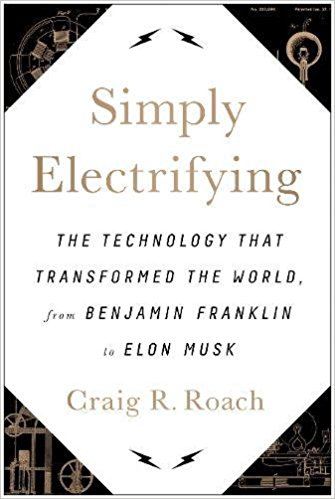You have /5 articles left.
Sign up for a free account or log in.
 Simply Electrifying: The Technology that Transformed the World, from Benjamin Franklin to Elon Musk by Craig R. Roach
Simply Electrifying: The Technology that Transformed the World, from Benjamin Franklin to Elon Musk by Craig R. Roach
Published in June of 2017.
Simply Electrifying attempts to integrate the complete 250-year history of electricity into a single 400 page (15 hour audio) book. The book starts at with Ben Franklin (always a pleasure for Franklin nuts such as myself), and ends with Elon Musk. In between, we learn about how electricity transitioned from the realm of experiments to that of industrial-scale production.
Simply Electrifying is certainly timely given the continued power outages in Puerto Rico, brought on by a combination of Hurricane Maria and an aging electricity infrastructures. What is clear from reading Simply Electrifying is just how preventable these electrical blackouts should be, given how many years that electricity generation and distribution has been an established technology. The same basic technology that powers our lights, air conditioners, and computers has been in use since at least the 1940s. Today, power outages are political failures - failures of planning and maintenance and resource allocation - not failures of technology.
Over the past few years I’ve become more curious about higher education infrastructure, and in particular about the energy in which we depend. Part of my interest was fueled the first open online course, Introduction to Environmental Science, that we developed and taught at my College. In that course, the professor Andy Friedland, used the story of power generation and use on our campus to teach about both the fundamental science of energy, and to discuss larger environmental and policy implications of energy choices. I’ve embedded an amazing 3:28 video in which Professor Friedland tours the Dartmouth Heating Plant at the end of this post.
What is fascinating is that between 40 and 45 percent of the electricity needs of the main Dartmouth campus come from the cogeneration heating plant. Currently, No. 6 fuel oil is burned to create steam, which before it is distributed around campus for heating buildings passes through two electricity generating turbines.
The balance of the electricity that is not generated in the College’s cogeneration plant is from the grid. The main utility in NH, Liberty Utilities, gets it electricity from the following sources (as of 2015): natural gas (31.4%), nuclear (30.7%), imported power (18.5%), oil (7.7%), biomass (3.9%), coal (3.6%), hydro (2.6%), municipal trash / landfill gas (.9%), wind (.7%).
Do you know how your campus electricity is generated?
Generating the electricity at my school requires burning 3,500,000 gallons of No. 6 fuel oil (to get the 40-45% of electricity), while purchasing the rest from the grid. The latest numbers I can find (2012-2013) show that the my school purchases $6 million a year of grid electricity, equaling 50M kWhs. Surprisingly, half of the electricity on campus goes to air conditioning, with 30% to lighting, and 20% for plug loads (everything that is plugged into an AC outlet).
Again, are you able to track down where the electricity that you use on your campus is generated, where it goes, and how much it costs?
Simply Electrifying does not cover higher education electricity. Perhaps that is a good thing, as the book tries to describe almost everything else in the long history of American electrical generation and distribution. The book would have benefited from a sharper narrative thread running through the history of electricity. Reading Simply Electrifying leaves one with a better understanding of the details of the electricity story, but less in the way of insights into why this history matters and where we may be going in the future.
Despite the imperfections of Simply Electrifying, I do recommend the book for anyone who has gotten the electricity bug. The ambition of the author to put the entire history of electricity into a single volume should be commended.
How you connect the history of electricity in the U.S. to the future of electricity on your campus is your challenge.
At my school there are big plans to move towards a more sustainable system of energy usage, including electricity. This includes transitioning from No. 6 fuel oil to renewable sources by 2025, reducing greenhouse gas emissions by 50 percent by 2025 (and 80 percent by 2050), and improving energy efficiency by 20 percent.
What books do you recommend about energy - and electricity - to help inform campus conversations about sustainability?
Where does your electricity come from?
What are you reading?




